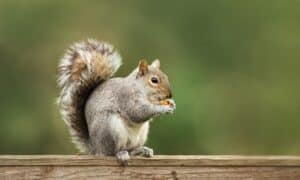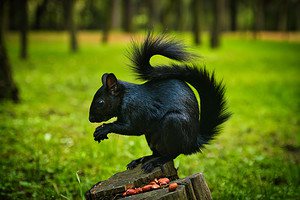Key Points:
- Eastern gray squirrels, fox squirrels, American red squirrels, western gray squirrels, and black squirrels are common squirrel species in North America.
- Squirrels dig in flower pots for various reasons, including burying food.
- Squirrels use their intelligence to remember the location of their buried food and can find it even months or years later.
Squirrels have long perplexed gardeners with their incessant digging in flower pots. This article explores the five main reasons behind this quirky behavior. From burying food for winter survival to searching for hidden treasures, understanding these motivations can help us coexist harmoniously with our furry neighbors while protecting our beloved plants. Let’s dive in and find out why squirrels dig in flower pots!
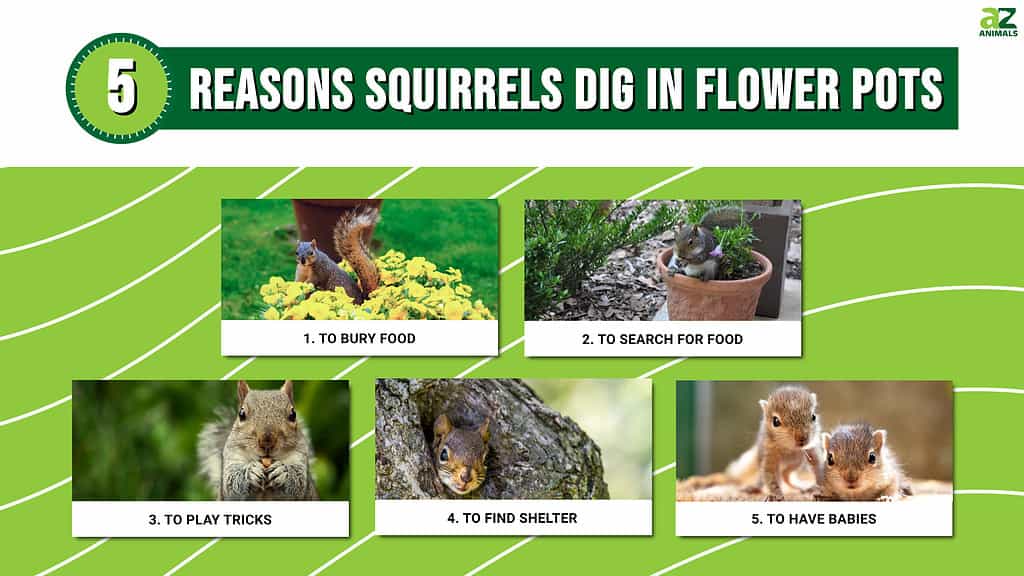
Types of Squirrels
There are dozens of types of squirrels that live in North America. These charismatic rodents are known for their bushy tails, agile climbing abilities, and fondness for digging in flower pots. Here are a few of our favorites!
Eastern Gray Squirrel
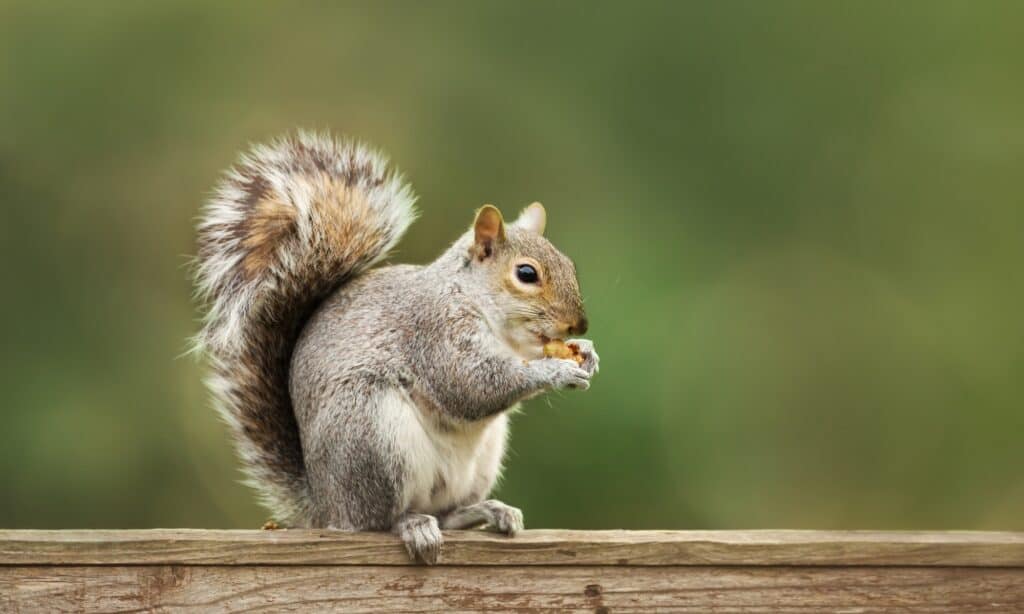
Eastern gray squirrels are a common animal to spot in North America.
©iStock.com/Dgwildlife
One common squirrel species found across the continent is the Eastern gray squirrel (Sciurus carolinensis). You can recognize their gray fur and white underbelly. These squirrels have adapted well to urban environments. You can see them scurrying through parks or suburban neighborhoods.
Fox Squirrel
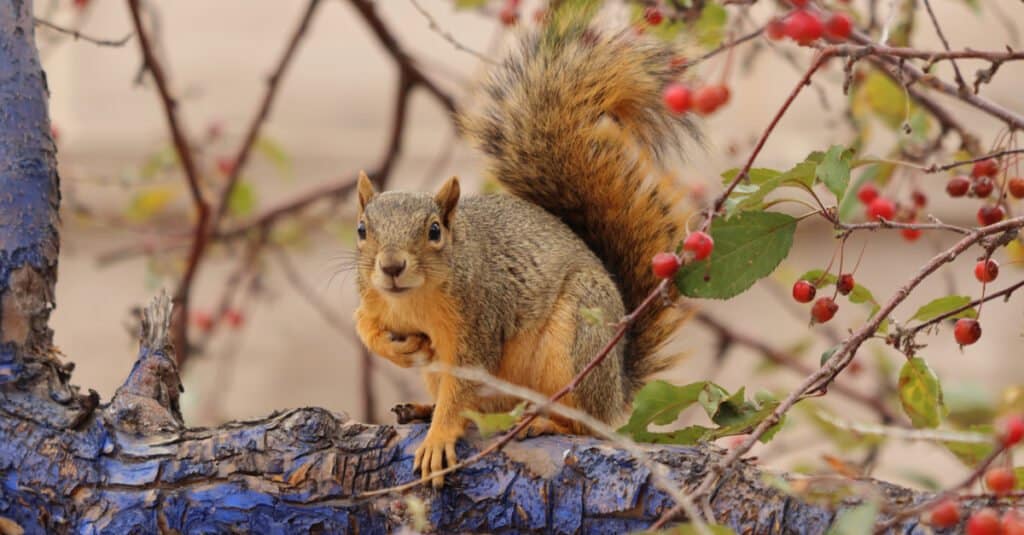
Fox squirrels like to live in wooded areas with plenty of trees.
©Vaclav Matous/Shutterstock.com
Another prevalent squirrel species in North America is the fox squirrel (Sciurus niger), which tends to live in wooded areas with dense vegetation. With its reddish-brown coat and distinctive fluffy tail, the fox squirrel adds a touch of natural beauty wherever it roams.
American Red Squirrel
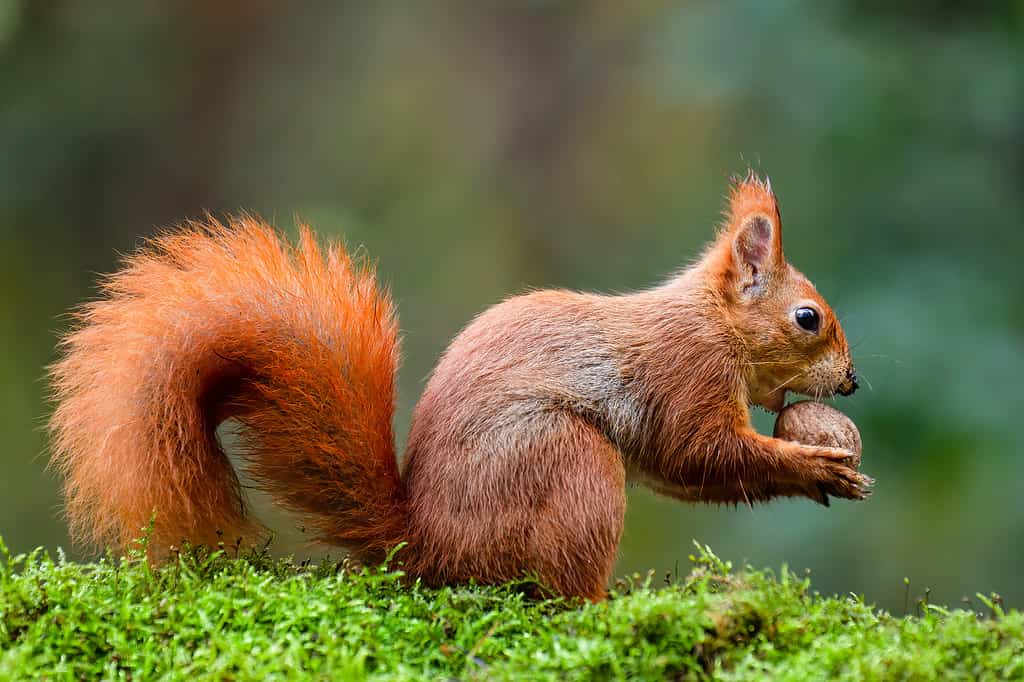
Red squirrels are known for their brilliant rusty hue.
©Koen Adriaenssen/Shutterstock.com
The American red squirrel (Tamiasciurus hudsonicus) is yet another fascinating member of the squirrel family frequently encountered in North America. Smaller than its counterparts, this energetic creature boasts a vibrant red coat with white tufts on its ears. It prefers to live in coniferous forests, where it darts among trees while collecting food supplies for winter.
Western Gray Squirrel

is the scientific name for the Western gray squirrel.
©iStock.com/Nancy Strohm
The western gray squirrel, a native of the Pacific Northwest region, is a fascinating creature known for its habit of digging in flower pots. With their bushy tails and sleek fur, these squirrels exhibit remarkable agility as they scurry through trees and leap from branch to branch. While their affinity for flower pots may puzzle some, it is believed that the act of digging serves various purposes, such as burying food or creating nests. These resourceful creatures are highly adaptable and can be found in urban as well as rural areas, making them an integral part of our ecosystem.
Black Squirrel

Black squirrels have distinctive black fur and beautiful coats.
©C. Hamilton/Shutterstock.com
The black squirrel (Sciurus carolinensis) is a subspecies of the Eastern gray squirrel, known for its distinctive black fur. Typically living in North America, particularly in regions with dense forest cover, these agile creatures are skilled climbers and foragers. Their diet consists of nuts, seeds, fruits, and occasionally insects. Despite their preference for natural food sources, they have also been observed digging in flower pots due to various reasons, such as searching for buried food or creating nests.
5 Reasons that Squirrels Dig in Flower Pots
Let’s dive in and find out why squirrels dig in flower pots! The reasons may surprise you.
1. To Bury Food
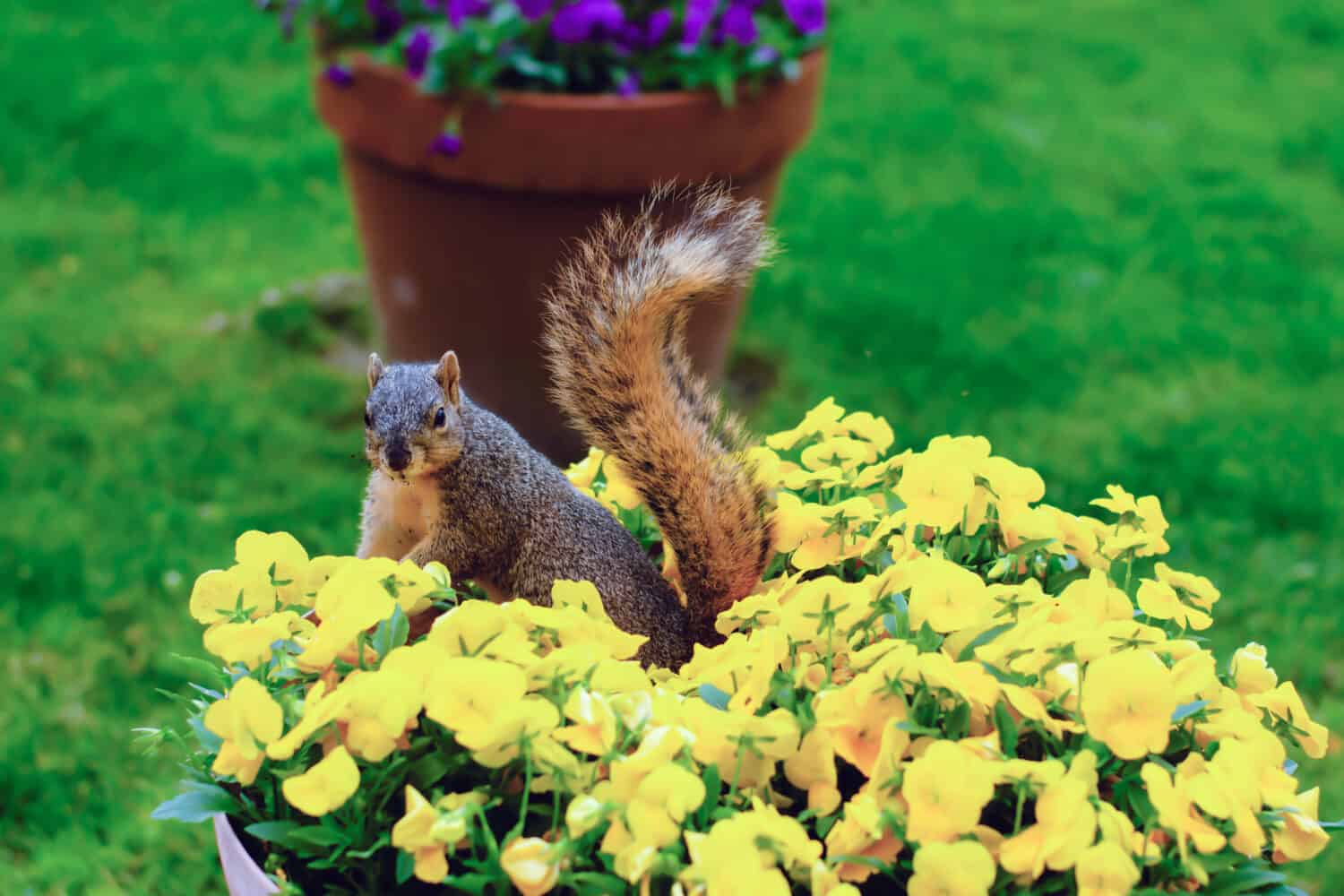
Burying food in flower pots helps keep it dry and safe from predators.
©Alissala/Shutterstock.com
Squirrels dig holes in flower pots for a variety of reasons, primarily to store and protect food. Squirrels often bury their food in the ground, where they are not as vulnerable to being stolen by predators. Flower pots provide an ideal environment for burying food because not only do they provide safety from predators, but they also help keep the food items dry. They are also full of nice soft, fluffy soil that is easy to dig in.
Squirrels typically use their teeth and claws to dig the holes. They will use their claws to break up the soil and then their teeth to pick out the individual pieces.
2. To Search for Food
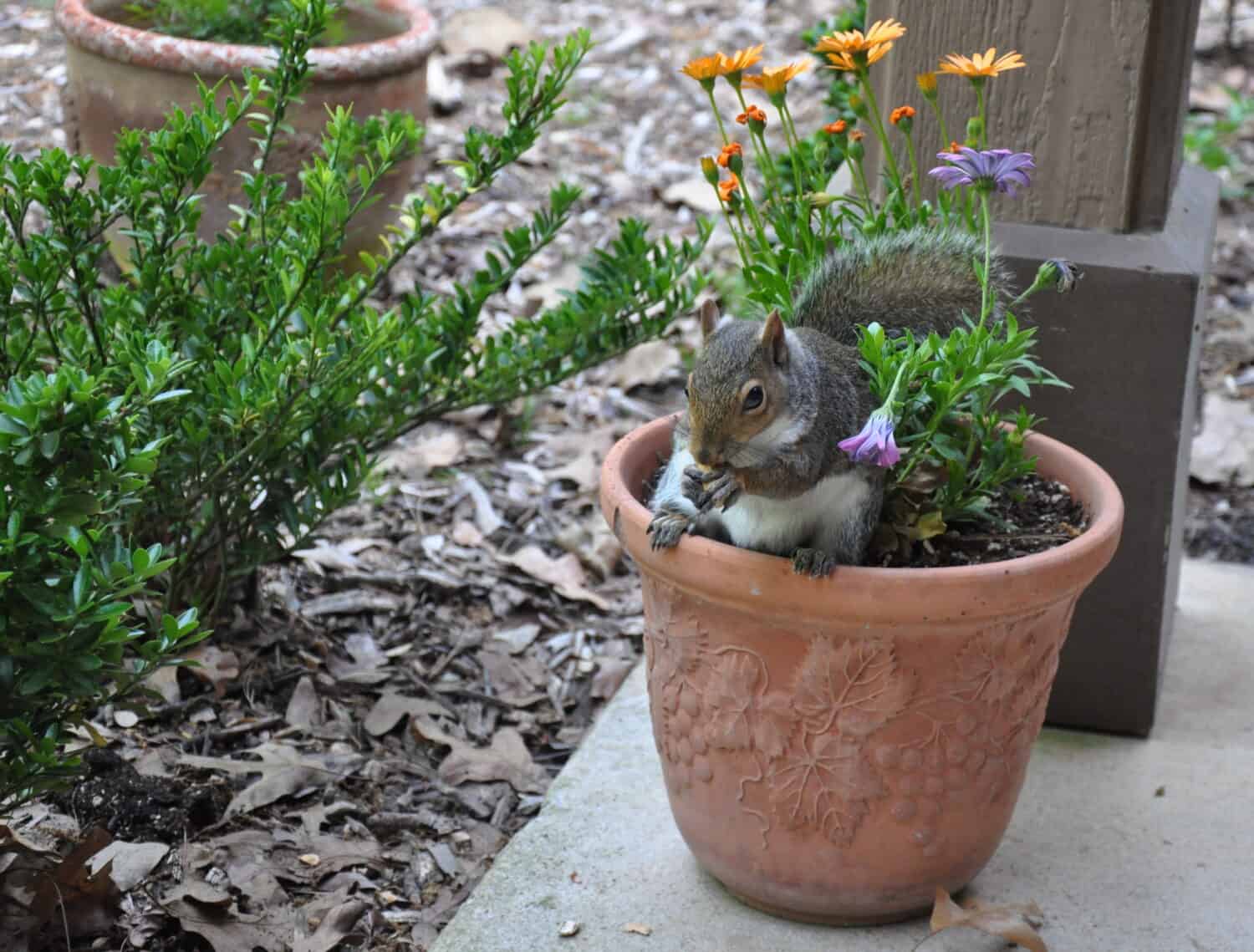
Squirrels may dig up flower posts to eat the roots or bulbs inside.
©Becky Sheridan/Shutterstock.com
Squirrels are notorious for digging up flower pots to get to the roots or flower bulbs inside. This can be a nuisance to gardeners and homeowners alike. Squirrels are incredibly agile and can quickly dig through soil and uproot plants. They are also very curious, so they may be drawn to explore a flower pot and see what’s inside.
When a squirrel digs up a flower pot, it can cause a lot of damage. The plant roots can be exposed, and the entire pot can be overturned. In some cases, the flower bulbs may be eaten by the squirrel.
Although it can be frustrating to have squirrels dig up flower pots, it’s important to remember that they’re just trying to find food and shelter. By taking the proper steps to deter them, you can make sure that your flower pots remain safe and sound.
3. To Play Tricks

Squirrels have developed cunning strategies to protect their food, such as pretending to bury it.
©iStock.com/sines-design
Squirrels are known for being cute, furry and mischievous. But what many don’t know is that they are also incredibly smart and have developed cunning strategies to protect their food. One of the most interesting strategies is their ability to pretend to bury food to trick potential thieves.
Squirrels usually bury their food, such as nuts and seeds, to keep them safe from other animals or birds. However, they have also been known to pretend to bury food and then quickly stash it away in a hidden spot. This tactic is used to fool other animals into thinking that the food has been buried and is no longer available.
In addition to this, squirrels also use their intelligence to remember the location of their buried food, which is incredibly impressive. They can remember the exact place where they stashed their food, even months or years after it has been hidden.
4. To Find Shelter

If a squirrel is outcompeted for den space, then a flower pot will have to do.
©RT Images/Shutterstock.com
Squirrels are resourceful animals that will use whatever they can find to create an appropriate shelter. If they cannot find a suitable home, they may opt to use an extra-large flower pot as a substitute. This is because flower pots are large enough to provide protection from the elements and predators, and they are easy to access.
These pots can also offer an ample supply of insulation to help keep squirrels warm in colder climates. Flower pots are also typically made of durable materials that can withstand the wear and tear of squirrels. Furthermore, flower pots can be placed in a variety of locations, making them easily accessible to squirrels.
Flower pots are not an ideal substitute for a home, but squirrels often have trouble finding the perfect location to stay warm. They use their ingenuity to test out a flower-pot-abode. They usually come to the conclusion on their own that this is not the best hide-out and abandon the plan.
5. To Have Babies
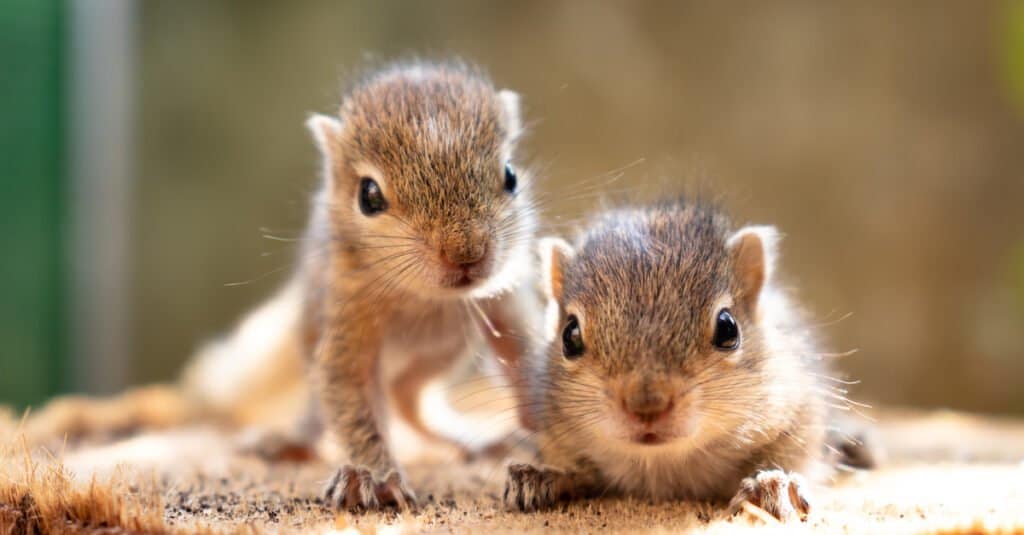
In an emergency, squirrels may use an extra large flower pot for a nest.
©Nilanka Sampath/Shutterstock.com
Squirrels are resourceful animals, and when it comes to finding a suitable place to raise their young, they often use large flower pots as a nesting site. This is due to a variety of reasons, such as a lack of available trees or the abundance of predators in the area.
When it comes to finding a safe place to have their babies, squirrels often rely on their ingenuity. Flower pots provide a sheltered and secure nook to raise their young, as the pots are often placed in areas where predators can’t easily access them. The pots also provide ample space to store food and other necessities, ensuring that the baby squirrels have all the resources they need to thrive.
In some areas, particularly those where there are a lot of squirrels, flower pots are often the only option available for the squirrels. With limited options, the squirrels are forced to use their wit and resourcefulness to find a safe and secure place to raise their young.
How to Keep Squirrels Out of Flower Pots
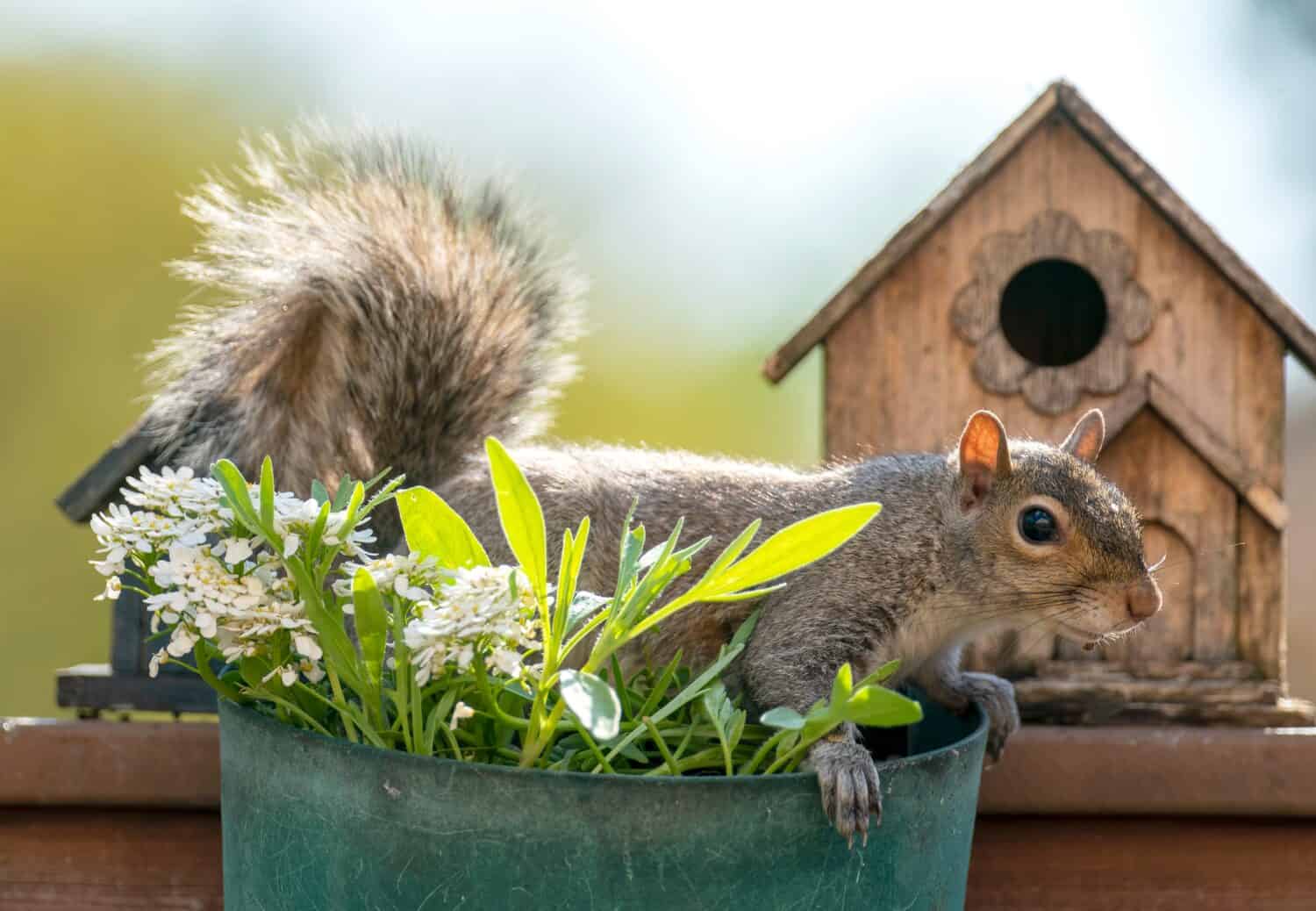
You can use gravel mulch to deter squirrels from digging in your flower pots.
©Tony Quinn/Shutterstock.com
Some people say to plant mint or garlic to deter squirrels, but that is not the most effective method. Others suggest using cayenne pepper spray or coffee grounds to keep squirrels out of flower pots. We don’t know if that works, but it may be worth a try. Don’t try this method if you have small children or pets in the garden. The best methods that we have found are exclusionary in nature.
1. Cover the Soil in Rocks
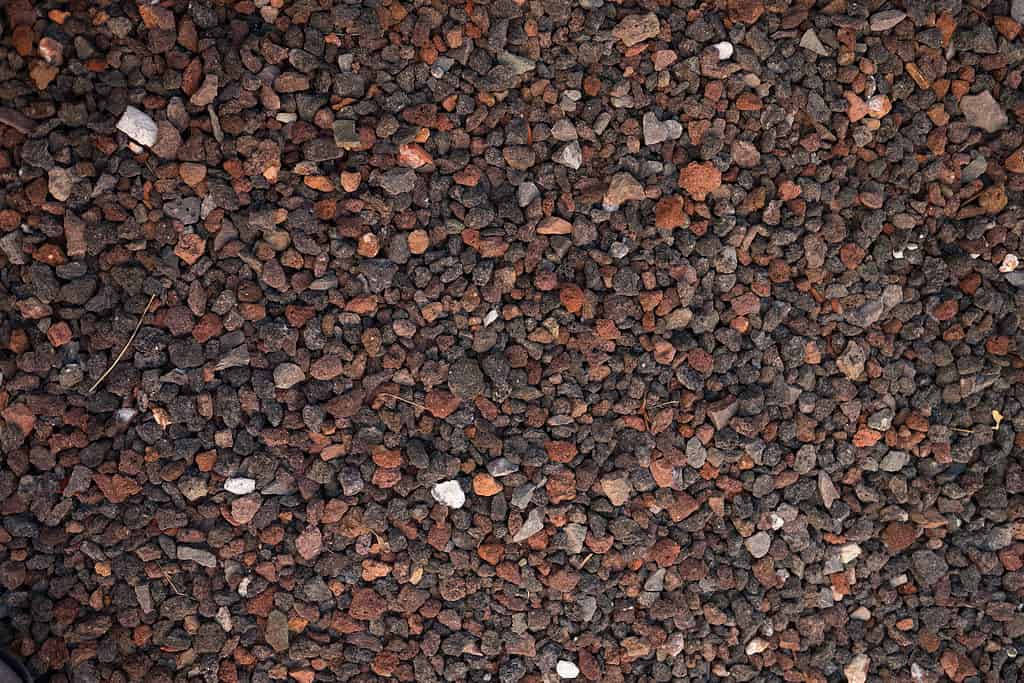
Sharp gravel as a mulch is one exclusion method that does not harm the squirrel.
©edwsg/Shutterstock.com
Using rocks or gravel to keep squirrels out of flower pots is an effective and natural way to protect plants. Rocks and gravel create an uncomfortable and uneven surface that squirrels find uncomfortable to traverse. Sharp gravel is not fun to dig in for delicate squirrel paws. You can use this as an effective deterrent for keeping them away from flowers and other plants.
Rocks and gravel also provide an effective physical barrier that squirrels are unable to dig through. The layer of rocks or gravel is thick enough to prevent the squirrels from digging down into the flower pots, making it difficult for them to access the plants and flowers.
2. Use a Chicken Wire Barrier
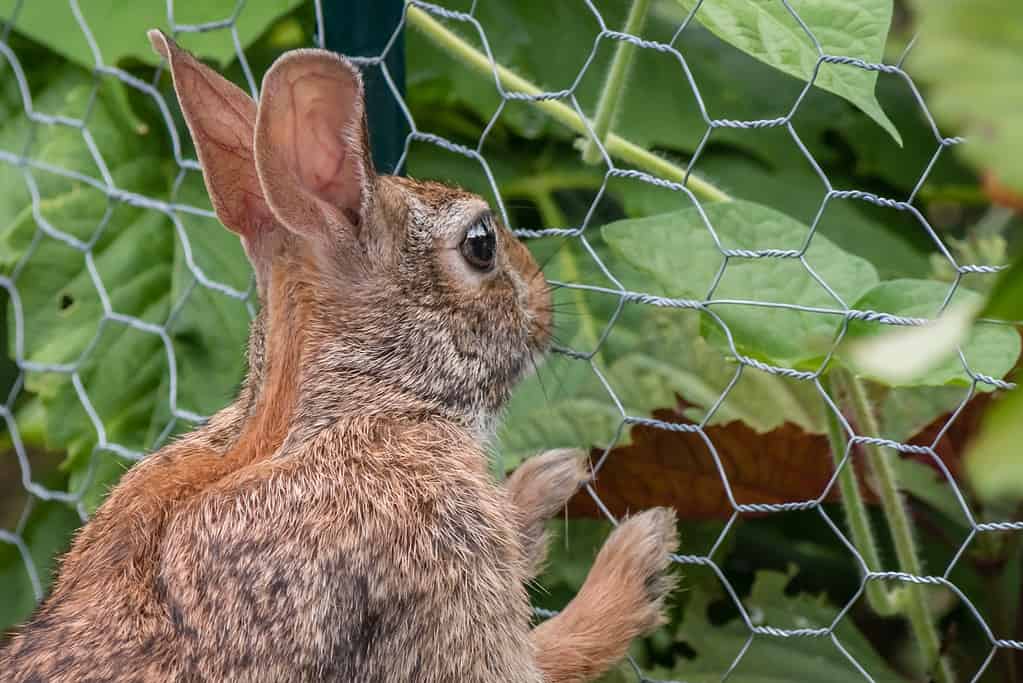
Chicken wire has been used to keep critters out of vegetable gardens and flower pots for years.
©Jay Gao/Shutterstock.com
After planting your flowers in the flower pot, cut a circle of chicken wire and lay it on top of the soil. Cover this wire with an inch of soil to hide it, or use a decorative mulch. This will help protect your flowers from any pesky intruders, such as squirrels.
When the squirrel comes to have a dig in your flower pot, they will not be able to dig down past the chicken wire and will move along. In addition to protecting your flowers from squirrels, chicken wire can also help to prevent other critters, such as cats, from digging up your flower pot.
3. Build a Cage to Protect Your Flower Pots
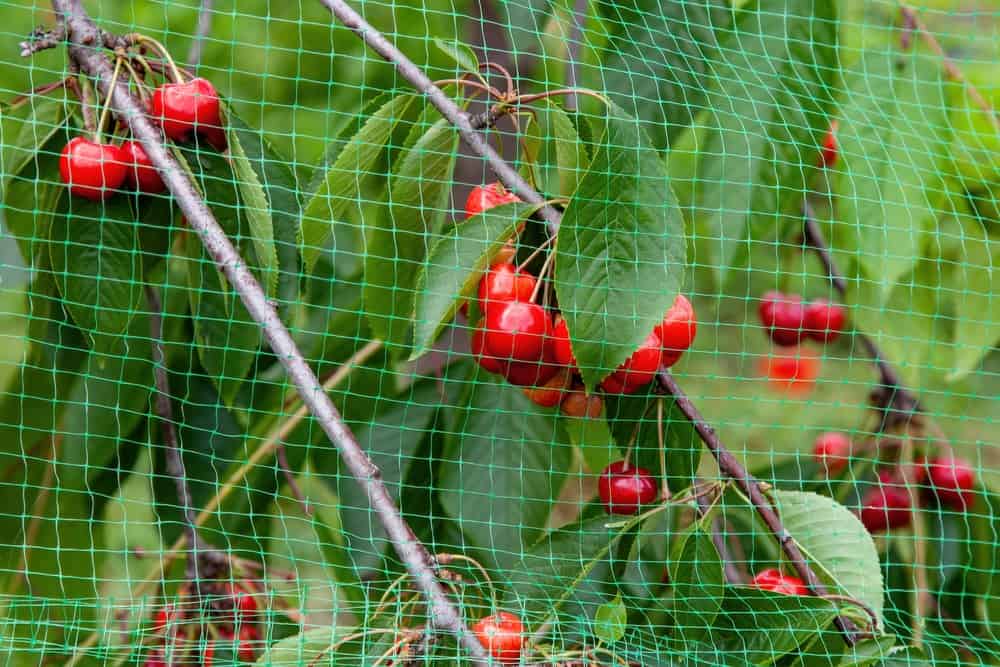
You can protect plants from pesky squirrels with a protective mesh.
©Vadym Zaitsev/Shutterstock.com
Constructing a wire cage to protect your flower pots from digging squirrels is easy. Here’s what you’ll need:
- Wire mesh
- Wire cutters
- Pliers.
Once you’ve gathered the materials, follow these steps:
- Cut the wire mesh into a square or rectangle that is large enough to fit around the flower pot.
- Cut four pieces of wire mesh into strips that will be used to make the frame of the cage.
- Place the strips around the perimeter of the square/rectangle and use the pliers to twist the ends of the strips together.
- Attach the frame to the wire mesh square/rectangle by twisting the frame to the mesh.
- Place the cage around the flower pot and secure it by twisting the frame together at the top.
And that’s it! You’ve now made a simple wire cage to protect your flower pot from pesky squirrels.
4. Plants That Squirrels Don’t Like
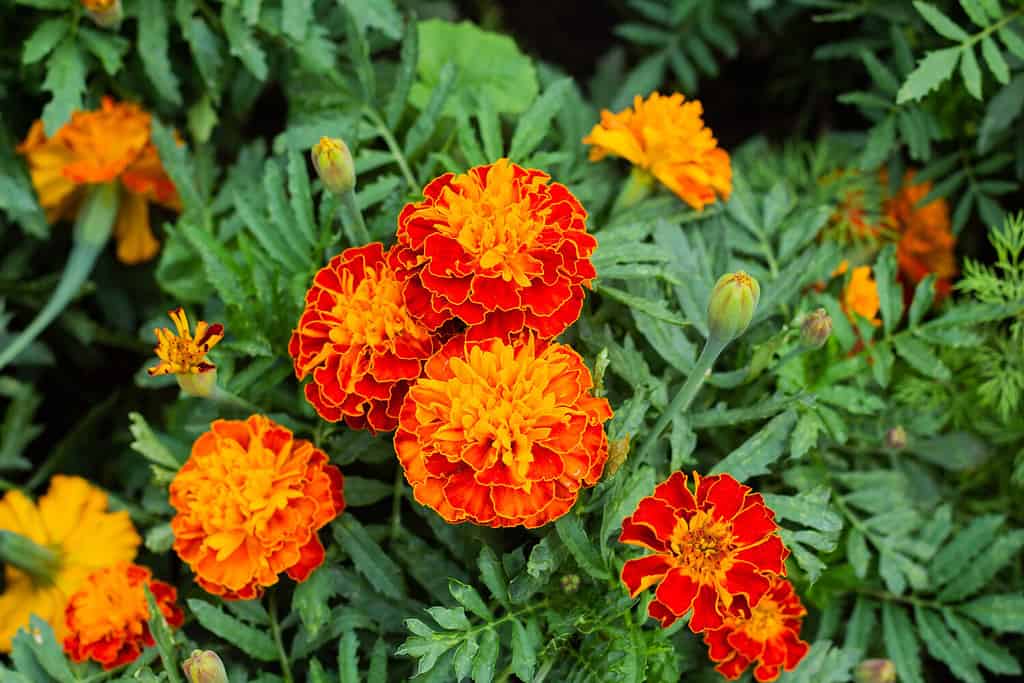
Squirrels think that marigolds do not taste very good at all.
©FunFamilyRu/Shutterstock.com
As an alternative to other methods, you can plant flowers that squirrels dislike, such as nasturtiums, mustard flowers, and marigolds. These vibrant blooms have a strong scent that will repel squirrels. Placing one or two repelling flowers in your pot will keep squirrels away. If you wish to have a plant in the pot, you can also place a smaller pot with repelling flowers beside it.
You can also mix your plants with other plants that squirrels don’t like, such as English ivy, lavender, and rosemary. This will help deter squirrels from entering the area and digging in your flower pots.
Summary of 5 Reasons that Squirrels Dig in Flower Pots
Here’s a recap of the five reasons why squirrels could be digging up the flower pots in your yard.
| Number | Reason |
|---|---|
| 1 | To bury food |
| 2 | To search for food |
| 3 | To play tricks |
| 4 | To find shelter |
| 5 | To have babies |
The photo featured at the top of this post is © Alissala/Shutterstock.com
Thank you for reading! Have some feedback for us? Contact the AZ Animals editorial team.





